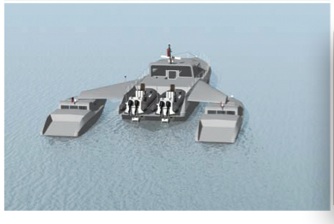Estudio conceptual de un buque modular configurable por misión
Palabras clave:
cascos de planeo, embarcaciones de alta velocidad, multicascos, comportamiento en el marResumen
Este trabajo muestra cómo las herramientas modernas de diseño de buques de alta velocidad pueden ser usadas para evaluar conceptos innovadores para los que los datos empíricos pueden ser limitados. El ejemplo presentado fue motivado por el interés de la Marina de los EE.UU. en reemplazar o complementar el buque de alta velocidad Mark V. Dados los requerimientos contradictorios de tamaño y peso reducido impuestos para poder ser transportados por aire frente a la capacidad de realizar un amplio rango de misiones, se propone y analiza una configuración modular multicasco. Se realiza la exploración del espacio de diseño de las variables que influencian el desempeño en aguas tranquilas, el comportamiento en el mar y las cargas estructurales. El diseño conceptual tipo trimarán muestra como la disposición adecuada de los cascos externos puede reducir las cargas de impacto y la resistencia del buque a cambio de un aumento en la complejidad estructural y potencialmente el peso de la embarcación.Descargas
Referencias bibliográficas
AKERS, R.H., HOECKLEY, S.A., PETERSON, R.S., AND TROESCH, A.W. (1999) Predicted vs. Measured Vertical-Plane Dynamics of a Planing Boat. FAST 1999. Seattle, Washington, USA.
AMERICAN BUREAU OF SHIPPING (2001) Guide for Building and Classing: High Speed Craft. Houston.
ALLEN, R.G. AND JONES, R.R. (1977) Considerations on the Structural Design of High Performance Marine Vehicles. SNAME, New York and Metropolitan Section Meeting, January 13.
BLOUNT, D.L. AND HANKLEY, D.W. (1976) Full Scale Trials and Analysis of High Performance Planing Craft Data. Transactions, SNAME, Vol. 84.
CLARK, V. (2002) SeaPower 21 Series Part I: Projecting decisive joint capabilities. Naval Institute Proceedings, October.
COOPER, S. AND NORTON, M. (2002) New paradigms in boat design: An exploration into unmanned surface vehicles. Association for Unmanned Vehicle Systems International Symposium.
FRIDSMA, G. (1971) A Systematic Study of Rough-Water Performance of Planing Hulls (Irregular Waves - Part II), Stevens Institute of Technology, March.
GALE, P.A. (2003) The Ship Design Process. Chapter 5, Ship Design and Construction. The Society of Naval Architects and Marine Engineers (SNAME), Jersey City, New Jersey, pp. 5-1 to 5-40.
HELLER, S.R. AND JASPER, N.H. (1960) On the Structural Design of Planing Craft. Quarterly Transactions, RINA. July.
HUGHES, O.F. (1988) Ship Structural Design: A Rationally-Based, Computer-Aided, Optimization Approach. SNAME, Jersey City.
SAVANDER, B.R. (1997) Planing Hull Steady Hydrodynamics. Ph.D. Thesis, Department of Naval Architecture and Marine Engineering, The University of Michigan.
SAVANDER, B.R., SCORPIO, S.M., AND TAYLOR, R.K. (2002) Steady Hydrodynamic Analysis of Planing Surfaces. SNAME, Journal of Ship Research, Vol. 46, No. 4.
SAVITSKY, D. AND BROWN, P.W. (1976) Procedures for Hydrodynamic Evaluation of Planing Hulls in Smooth and Rough Water. Marine Technology, SNAME, October 1976.
SOKOL, W. AND HANSEN, E. (2001) Unmanned vehicles: A technology whose time has come. July 2001 Excerpt. www.dt.navy.mil.
SPENCER, J.S. (1975) Sructural Design of Aluminum Crewboats. Marine Technology, SNAME, New York, July.
TULIN, M. P. (1957) The theory of slender planing surfaces at high speed. Schiffstechnik, 4, 1225-133.
VORUS, W.S. (1996) A flat cylinder impact theory for analysis of vessel impact loading and steady planing resistance. Journal of Ship Research, Vol. 40, No. 2, pp. 89-106.
WAGNER, H. (1932) Uber stross-und gleitvorgange an der oberflache von flussigkeiten. ZAMM, 12 pp. 193-215.
ZARNICK, E.E. (1978) A Nonlinear Mathematical Model of Motions of a Planing Boat in Regular Waves. David W. Taylor Naval Ship Research and Development Center. Report Number DTNSRDC-78/032.
ZARNICK, E.E. (1979) A Nonlinear Mathematical Model of Motions of a Planing Boat in Irregular Waves. David W. Taylor Naval Ship Research and Development Center. Report Number DTNSRDC/SPD-0867-01.

Descargas
Cómo citar
Número
Sección
Licencia
The authors who publish in this Journal certify that:
- The work submitted for publication in The Ship Science and Technology journal, was written by the author, given that its content is the product of his/her direct intellectual contribution.
- All data and references to material already published are duly identified with their respective credits and are included in the bibliographic notes and quotations highlighted as such.
- All materials submitted for publication are completely free of copyrights; consequently, the author accepts responsibility for any lawsuit or claim related with Intellectual Property Rights thereof, Exonerating of responsibility to The Science and Technology for the Development of Naval, Maritime, and Riverine Industry Corporation, COTECMAR.
- In the event that the article is chosen for publication by The Ship Science and Technology journal, the author state that he/she totally transfers reproduction rights of such to The Science and Technology for the Development of Naval, Maritime, and Riverine Industry Corporation, COTECMAR.
- The authors retain the copyright and transfer to COTECMAR the right of publication and reproduction of the work which will be simultaneously subject to the Creative Commons Attribution License (CC - BY), which allows the license to copy, distribute, display and represent the work and to make derivative works as long as it recognizes and cites the work in the manner specified by the author or licensor.
- For more information about the Creative Commons Attribution License (CC -BY) and his use and scope, please visit the following web page https://creativecommons.org/licenses/by-sa/4.0/legalcode








